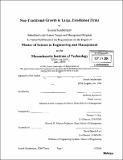| dc.contributor.advisor | Rebecca Henderson. | en_US |
| dc.contributor.author | Sunderrajan, Suresh, 1970- | en_US |
| dc.contributor.other | System Design and Management Program. | en_US |
| dc.date.accessioned | 2006-11-08T16:41:52Z | |
| dc.date.available | 2006-11-08T16:41:52Z | |
| dc.date.copyright | 2004 | en_US |
| dc.date.issued | 2004 | en_US |
| dc.identifier.uri | http://hdl.handle.net/1721.1/34809 | |
| dc.description | Thesis (S.M.)--Massachusetts Institute of Technology, System Design & Management Program, 2004. | en_US |
| dc.description | Includes bibliographical references (p. 96-99). | en_US |
| dc.description.abstract | Firms must continuously strive to grow through the creation of new sources of competitive advantage. The challenges to growth are more severe for large, established firms that derive a predominant amount of their present revenue from technology that is mature and that faces imminent substitution through the marketplace emergence of a disruptive technology. In such circumstances, non-traditional growth, through new business opportunities outside of the direct purview of established Strategic Business Units, becomes an imperative. The primary hypothesis of this study is that problems in achieving growth predominantly stem from the inherent rigidities of large, established firms and, in order to successfully grow, these firms will have to pay particular attention to the structures and processes associated with teams tasked with growth. Accordingly, a theoretical framework for classifying non-traditional growth opportunities is developed. The study is motivated using three examples of non-traditional growth projects in a large, established firm. These examples are used to develop three key dimensions for characterizing such opportunities--technology, market, and organization. The proposed framework builds upon structural contingency theories to develop two independent factors for each dimension--uncertainty and interdependence. A vector mapping applicable to all non-traditional growth opportunities is developed using the two factors and three dimensions. The vector mapping is used to propose a linkage between growth opportunity and organizational form. A survey administered to 24 project leaders/managers of non-traditional growth projects in a single, large firm is used to test the applicability of the framework developed here. A statistical | en_US |
| dc.description.abstract | (cont.) analysis of the survey results corroborates the significance of market and technology factors. Organizational factors appear to be less significant, but this may be due to artifacts in the data. Finally, a concept explored in this study is that organizations must become more ambidextrous in their ability to use multiple organizational forms, simultaneously, to exploit non-traditional growth opportunities. Implementation considerations relevant to the recommended organizational forms are discussed within the specific product development process framework in a single, large firm. | en_US |
| dc.description.statementofresponsibility | by Suresh Sunderrajan. | en_US |
| dc.format.extent | 138 p. | en_US |
| dc.format.extent | 8774446 bytes | |
| dc.format.extent | 8792557 bytes | |
| dc.format.mimetype | application/pdf | |
| dc.format.mimetype | application/pdf | |
| dc.language.iso | eng | en_US |
| dc.publisher | Massachusetts Institute of Technology | en_US |
| dc.rights | M.I.T. theses are protected by copyright. They may be viewed from this source for any purpose, but reproduction or distribution in any format is prohibited without written permission. See provided URL for inquiries about permission. | en_US |
| dc.rights.uri | http://dspace.mit.edu/handle/1721.1/7582 | |
| dc.subject | System Design and Management Program. | en_US |
| dc.title | Non-traditional growth in large, established firms | en_US |
| dc.type | Thesis | en_US |
| dc.description.degree | S.M. | en_US |
| dc.contributor.department | System Design and Management Program. | en_US |
| dc.identifier.oclc | 60314152 | en_US |
